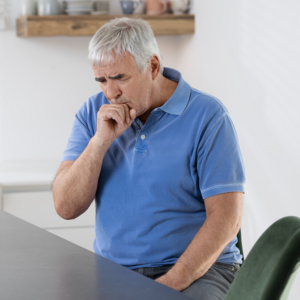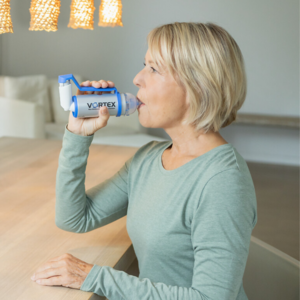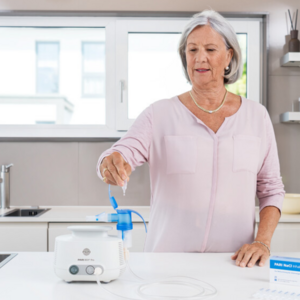
People with chronic obstructive pulmonary disease (COPD) are particularly vulnerable to respiratory infections. These infections not only have the potential to cause lasting damage to lung function, but can also result in serious complications such as heart attacks or strokes. In this interview, pulmonologist Prof. Rainald Fischer explains the reasons behind this and what steps COPD patients can take to protect themselves from colds and respiratory infections.
Prof. Dr Fischer: Respiratory infections pose a significant danger to people with COPD. This is because they have been proven to increase mortality in this group. That means that a patient with a serious respiratory infection is at an increased risk of dying in the weeks and months following the infection. Any respiratory infection also raises the overall mortality risk. COPD patients should therefore ideally avoid any respiratory infection.
Prof. Dr Fischer: Firstly, the infections lead to severe exacerbations, leading not only to acute but also chronic declines in lung health. In people with COPD, there is also the risk that respiratory infections may be accompanied by cardiac events such as heart attacks, strokes or cardiac arrhythmias, thereby further raising the risk of mortality.
Prof. Dr Fischer: A stuffy nose or a mild cold are not inherently dangerous – provided they are confined to the upper airways, i.e. the nose, throat and larynx. However, in people with COPD there is always the risk that the infection may spread to the lower airways because the lungs are already compromised. And it is when this happens that the infection can have serious health consequences.
Added to this, it is not usually possible to treat viral infections at their source. This makes it all the more important to avoid them in the first place – even if they initially appear to be harmless. What starts as just a simple cold can become serious in COPD patients and can cause lasting damage to the lungs.
Prof. Dr Fischer: Patients cough more, are short of breath and feel that they are able to do less. Pulmonary function tests, if performed, show a drop in one-second forced expiratory volume and an increase in the narrowing of the bronchial tubes. Blood tests show elevated inflammatory markers. This acute deterioration lasts many weeks.
Even in people who do not have chronic lung disease, an infection of the lower airways can linger for up to four weeks – and even up to eight weeks in unfavourable cases. This means that the symptoms last a relatively long time and it is during this time that patients with COPD tend to develop additional cardiovascular diseases.
Prof. Dr Fischer: It is assumed that COPD as a disease is not confined solely to the lungs, but that the inflammation in the bronchial tubes may also lead to heightened inflammation throughout the body. These inflammatory responses can also affect the heart region and result in changes to the heart. The inflammatory activity can, for instance, promote the development of blood clots, which may in turn result in a heart attack in the coronary vessels.
Prof. Dr Fischer: In short, get vaccinated, wear a face mask, adhere consistently to your long-term treatment regimen and possibly also incorporate inhalation therapy. These are measures that can protect you from respiratory infections and colds. I am happy to address the individual points in more detail.
Vaccinations are the most important tool in the arsenal. It is essential that patients with COPD have the flu jab and the COVID-19 jab every year. The RSV vaccine is now also approved for patients aged 60 and over with pre-existing respiratory diseases such as COPD. So this is a vaccine against respiratory syncytial virus which occurs mainly in infants and young children, but can also affect adults and trigger exacerbations in COPD. Getting vaccinated against pneumococci is also helpful, i.e. a vaccine to protect against pneumonia.

The second protective measure is to wear a face mask when exposed to large numbers of people, such as on public transport, in doctor’s surgeries, at the supermarket or other gatherings.

The basic rule is to consistently stick to your prescribed long-term treatment regimen. The use of a spacer is advisable for inhalation therapy with bronchodilators and corticosteroid sprays as this significantly improves drug dispersal in the bronchial tubes while minimising some side effects of spray inhalation, such as oral thrush.
Inhalation therapy with saline solution can help give the airways the best possible care, especially in the cold months of the year.
Prof. Dr Fischer: Inhalation therapy with a saline solution can have a supportive effect. It helps moisten the airways, keep the respiratory environment clean and potentially clear out pathogens that have made their way into the airways. Many patients report that inhalation therapy with a nebuliser is very soothing, especially in autumn and winter when the air indoors is dry from the central heating.
At this point, it is important to note that there are currently no reliable, placebo-controlled studies that prove that inhalation therapy reduces the frequency of respiratory infections. Nonetheless, it is still recommended from a medical point of view – simply by dint of the fact that there are not many other ways to prevent colds.

Prof. Dr. Fischer: Das Inhalationsgerät sollte feine Tröpfchen mit einer Größe von ≤ 5 Mikrometern erzeugen, damit diese tief in die Bronchien gelangen. Das Gerät sollte leistungsstark genug sein, um 5 ml Lösung in ca. 5–10 Minuten zu vernebeln – sonst ist die Anwendung zu langwierig. Die Verneblerteile müssen regelmäßig gereinigt und desinfiziert werden – entweder durch Abkochen oder in einem Vaporisator, um sicherzustellen, dass sich keine Viren und Bakterien in den Verneblerteilen befinden. Dafür müssen die Teile geeignet sein.
Essential measures:
Supportive measures (experience of COPD patients):
Prof. Dr Rainald Fischer is a specialist for internal medicine in private practice, with a subspecialty in lung and bronchial medicine, specialty of emergency medicine, sleep medicine and allergy medicine in Munich-Pasing. Before that he worked as an internist and lung specialist, most recently as a senior physician at the Munich university hospital. Prof Dr Rainald Fischer is a founding member and president of the Deutschen Gesellschaft für Berg- und Expeditionsmedizin (German Society for Mountain and Expedition Medicine), and also a member of the Cystic Fibrosis Medical Association.
Note: The information in this blog post is not a treatment recommendation. The needs of patients vary greatly from person to person. The treatment approaches presented should be viewed only as examples. PARI recommends that patients always consult with their physician or physiotherapist first.
An article written by the PARI BLOG editorial team.
© 2025 PARI GmbH Spezialisten für effektive Inhalation